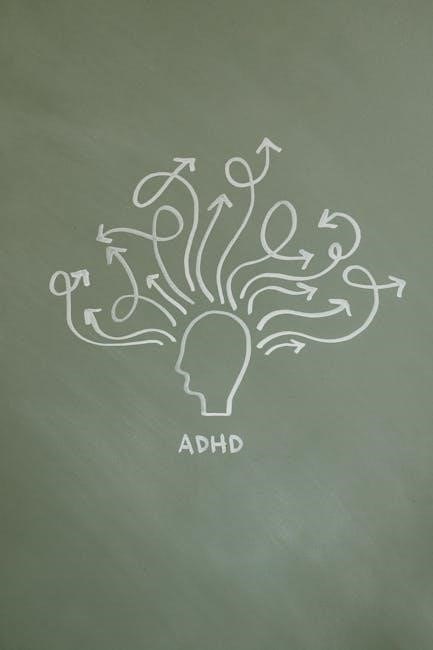The ADHD-RS-5 is an 18-item scale assessing ADHD symptoms in children and adolescents, aligned with DSM-5 criteria, used by parents and teachers to evaluate attention and behavior.
Overview of the ADHD-RS-5
The ADHD-RS-5 is an 18-item rating scale designed to assess ADHD symptoms in children and adolescents aged 6–17. It aligns with DSM-5 criteria, evaluating inattention and hyperactivity. Parents and teachers complete the scale, which takes about 5 minutes; It provides a clear, standardized method to measure symptom severity, aiding in diagnosis and monitoring treatment progress. The scale is straightforward for non-clinicians to use, making it a practical tool in both clinical and educational settings.
Development and Purpose of the ADHD-RS-5
The ADHD-RS-5 was developed to align with the DSM-5 criteria, providing a standardized tool for assessing ADHD symptoms in children and adolescents. Initially designed for pediatric use, it has been adapted to include adult-specific prompts, enhancing its versatility. The scale aims to aid clinicians in diagnosing ADHD, monitoring treatment progress, and evaluating functional impairment. Its development emphasizes cost-effectiveness and ease of use, with a limited duplication license allowing professionals to reproduce forms for clinical purposes, making it a practical and accessible diagnostic resource.
Structure of the ADHD-RS-5
The ADHD-RS-5 features an 18-item scale directly corresponding to DSM-5 ADHD symptoms, assessing inattention and hyperactivity/impulsivity. It includes both home and school versions for comprehensive evaluation.
18-Item Scale and DSM-5 Criteria
The ADHD-RS-5 consists of 18 items, each corresponding to DSM-5 symptoms of ADHD, divided into inattention (9 items) and hyperactivity/impulsivity (9 items). This structure ensures comprehensive assessment of core ADHD symptoms. The scale is designed for parents and teachers to evaluate behaviors observed in children and adolescents. Each item is rated on a 4-point Likert scale, from 0 (never) to 3 (very often), providing a clear measure of symptom severity. Its alignment with DSM-5 criteria enhances its validity for diagnostic and monitoring purposes.
Scoring and Interpretation Guidelines
The ADHD-RS-5 is scored by summing ratings across 18 items, each rated on a 4-point scale (0-3). Total scores range from 0 to 54, with higher scores indicating greater symptom severity. A cutoff score of 14 or higher suggests ADHD symptoms consistent with DSM-5 criteria. Scores are interpreted based on age and gender norms, providing a standardized measure of symptom severity. This system aids in diagnosing ADHD and monitoring treatment response over time.

Administration and Use of the ADHD-RS-5
The ADHD-RS-5 is a parent- and teacher-reported scale, completed independently in about 5 minutes. It is designed for assessing ADHD symptoms in children and adolescents across home and school settings.
Who Can Administer the Scale?
The ADHD-RS-5 can be administered by parents and teachers, as it is specifically designed for their use in assessing ADHD symptoms in children and adolescents. The scale is straightforward, requiring approximately 5 minutes to complete, and is intended for use in both home and educational settings. While parents and teachers can complete the scale, a qualified healthcare professional is ultimately required to interpret the results and make a formal diagnosis.
How to Complete the Scale
To complete the ADHD-RS-5, respondents rate each of the 18 items on a 4-point scale, ranging from 0 (never) to 3 (very often). The items correspond directly to DSM-5 ADHD symptoms. Parents and teachers independently assess the child’s behavior, typically taking about 5 minutes. The scale includes prompts specific to adult ADHD symptoms, enhancing its versatility. After completion, the forms and score sheets can be reproduced under a limited duplication license, offering cost savings. The results provide valuable insights for healthcare professionals to aid in diagnosis and treatment planning.
Applications of the ADHD-RS-5
The ADHD-RS-5 is widely used in clinical and educational settings to assess ADHD symptoms in children and adolescents, aiding in diagnosis, treatment monitoring, and functional behavior evaluation.
Clinical Use for Diagnosis and Monitoring
The ADHD-RS-5 is a valuable tool for clinicians to assess ADHD symptoms in children and adolescents. It evaluates inattention and hyperactivity/impulsivity, aligning with DSM-5 criteria. Designed for ages 6–17, it provides a standardized method to monitor symptom severity and treatment response. Clinicians use the scale to guide diagnostic decisions and track progress over time, ensuring informed treatment planning and better patient outcomes.
Educational Settings and Teacher Reporting
The ADHD-RS-5 is widely used in educational settings to assess ADHD symptoms in students. Teachers complete the scale to evaluate attention, behavior, and academic functioning. It aligns with DSM-5 criteria, providing a standardized tool for identifying students who may need support. The scale helps educators monitor homework performance, self-esteem, and peer interactions, enabling them to develop targeted strategies for students with ADHD. Its ease of use and focus on functional impairment make it a valuable resource for school-based assessments.
Scoring and Interpretation
The ADHD-RS-5 is scored on a 4-point Likert scale, with total scores ranging from 0 to 36. Higher scores indicate greater symptom severity, aiding in diagnosis and monitoring.
Cutoff Scores and Diagnostic Thresholds
The ADHD-RS-5 uses cutoff scores to guide diagnosis. For adults, a score of 14 or higher suggests ADHD symptoms, accurately identifying 91.4% of adults with ADHD and 96% without. While specific cutoffs for children are not detailed here, the scale provides clear thresholds to determine symptom severity and guide clinical decisions, aiding in accurate diagnosis and treatment planning.
Understanding the Results
Interpreting ADHD-RS-5 results involves evaluating symptom severity and functional impact. Scores help identify how ADHD affects daily functioning at home and school. Higher scores indicate more severe symptoms; Results are essential for diagnosis and treatment planning, providing insights into attentional and behavioral challenges. Clinicians use these scores to guide interventions and monitor progress over time, ensuring tailored support for individuals with ADHD.

Benefits of Using the ADHD-RS-5
The ADHD-RS-5 offers convenience, cost-effectiveness, and alignment with DSM-5 criteria. It provides quick, reliable insights into ADHD symptoms, aiding diagnosis and treatment monitoring effectively for clinicians and educators.
Convenience and Cost-Effectiveness
The ADHD-RS-5 is a time-efficient tool, requiring only 5 minutes to complete. Its design allows parents and teachers to easily assess ADHD symptoms. The scale’s flexibility enables use in various settings, including homes and schools. Cost-effectiveness is enhanced by a limited duplication license, permitting users to reproduce forms and score sheets, reducing expenses compared to other scales. This accessibility makes it a practical choice for frequent monitoring and assessment needs.
Alignment with DSM-5 Criteria
The ADHD-RS-5 is specifically designed to align with the diagnostic criteria for ADHD outlined in the DSM-5. It includes 18 items directly corresponding to DSM-5 symptoms, covering both inattention and hyperactivity/impulsivity. This alignment ensures accurate assessment of ADHD symptoms in children and adults. The scale’s structure mirrors the DSM-5 framework, making it a reliable tool for clinicians to diagnose and monitor ADHD effectively. Its consistency with DSM-5 criteria enhances its validity and utility in clinical and educational settings.

Limitations of the ADHD-RS-5
The ADHD-RS-5 relies on subjective reporting, potentially introducing biases. It is primarily designed for pediatric use, limiting its applicability for adults. Professional evaluation is essential for accurate diagnosis.
Potential Biases in Reporting
The ADHD-RS-5 is susceptible to reporting biases as it relies on observers’ perceptions. Parents and teachers may interpret behaviors differently, leading to variability in scores. Cultural factors and personal experiences can influence ratings, potentially resulting in over- or underestimation of symptoms. Additionally, the scale’s subjective nature means it may not capture the full complexity of ADHD manifestations across different settings and individuals. This underscores the need for comprehensive clinical evaluations to complement the scale’s findings.
Necessity of Professional Evaluation
While the ADHD-RS-5 provides valuable insights, it is not a standalone diagnostic tool. A qualified healthcare professional must interpret the results within a comprehensive evaluation. This ensures accuracy, as the scale measures symptoms but does not confirm ADHD. Clinicians must integrate results with other assessments, medical history, and observational data to make an accurate diagnosis. Relying solely on the ADHD-RS-5 could lead to misdiagnosis, emphasizing the critical role of professional expertise in ADHD assessment and treatment planning.

Comparison with Other ADHD Rating Scales
The ADHD-RS-5 aligns with DSM-5 criteria, offering a concise 18-item assessment, distinguishing it from longer scales like the Conners Adult ADHD Rating Scales and ASRS-5.
Similarities and Differences with ASRS-5
Both ADHD-RS-5 and ASRS-5 align with DSM-5 criteria, providing structured assessments of ADHD symptoms. However, the ADHD-RS-5 is an 18-item scale for parents and teachers, focusing on children and adolescents, while the ASRS-5 is a 6-question self-report tool for adults. Key differences include target populations and administration methods, though both aim to identify ADHD symptoms effectively for diagnostic and monitoring purposes.
Comparison with Conners Adult ADHD Rating Scales
Both ADHD-RS-5 and Conners Adult ADHD Rating Scales assess ADHD symptoms aligned with DSM-5 criteria. However, the Conners scales are specifically designed for adults, focusing on self-reported symptoms of inattention and hyperactivity. In contrast, the ADHD-RS-5 is tailored for children and adolescents, completed by parents or teachers. While both tools provide valuable insights, the Conners scales offer a more detailed evaluation of adult-specific ADHD manifestations, making them distinct in their application and scope.
The ADHD-RS-5 is a valuable tool for assessing ADHD symptoms, offering insights into attention and behavior in children and adolescents, aligned with DSM-5 criteria.
Final Thoughts on the ADHD-RS-5
The ADHD-RS-5 is a valuable tool for assessing ADHD symptoms in children and adolescents, aligning with DSM-5 criteria. Its convenience and effectiveness make it a reliable resource for parents, teachers, and clinicians. By providing a clear and structured approach to evaluating attention and behavior, the ADHD-RS-5 aids in diagnosis, monitoring, and treatment planning. Its widespread use underscores its importance in understanding and managing ADHD, offering a cost-effective solution for consistent and accurate assessments.